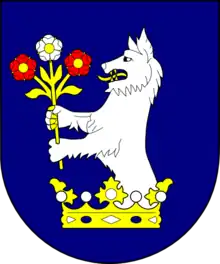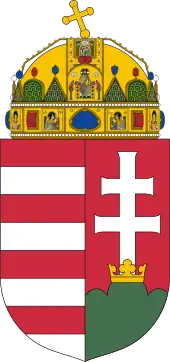
Hungarian heraldry generally follows German heraldry in its artistic forms, but has its own distinctive character. It is classified to Central and Eastern European heraldry.
Private armory
One of the most common devices found on Hungarian shields is a symbol of the many Turkish invasions of Hungary: the head of a Turk with a black mustache wearing a turban, blood dripping from the neck. At least 15 percent of all Hungarian personal arms include the severed head of a Turk,[1][2][3] Also popular were the griffin, bear, sun, moon, stars, horses, men on horseback, swords and a green dragon with a red cross on its body.[3] A coronet often replaces the wreath above the helmet. The mantling is often a combination of more than two tinctures, the most common being blue and gold on the dexter side and red and silver on the sinister.[3] Hungarian heraldry also employs a clan system instead of individual arms.[3] The arms of the old kingdom of Hungary included St. Stephen's cross, lions' heads, eagles and a six-pointed star representing the old kingdoms and provinces of Bosnia, Croatia, Dalmatia, Herzegovina, Slavonia, and Transylvania.[3]
Most Hungarian coats of arms are figurative; arms with simple divisions of the shield, or charged with ordinaries and subordinaries only, are extremely rare and mostly of foreign origin. The color of the field is most often blue, representing the sky. Around 90% of Hungarian arms have a green base, often a trimount.
In many cases mantling has more than two tinctures. The barred helm is normally used, but this is not a rule. There are few Hungarian arms without a crest coronet.
Due to great demand of soldiers during the wars against the Turks in the 16th and 17th centuries, sometimes a whole garrison of 80 to 120 soldiers was raised to nobiliary rank, being granted one coat of arms for all of them to share.
Official armory

The double cross was an ancient element in the arms of Hungary. It may have been given to Saint Stephen by the pope as the symbol of the apostolic Kingdom of Hungary. Today, the most accepted theory is that it derives from Byzantine influence, as the cross appeared around 1190 during the reign of King Béla III, who was raised in the Byzantine court.
The red and white stripes were the symbol of the Árpáds, the dynasty of the first Hungarian kings (1000-1301), and they were first used in the coat of arms in 1202 on a seal of King Emeric.
The coat of arms with the stripes on the dexter half and the cross on the hills on the sinister half appeared during the reign of Louis I of Hungary (1342-1382). The crown above the coat of arms appeared during the reign of Vladislaus I of Hungary (1440-1444). At first it was only a non-specific diadem but on the 1464 seal of Matthias Corvinus it resembled more the Holy Crown of Hungary.
The three green hills represent the mountains Tátra, Mátra and Fátra (made up of the Veľká Fatra and Malá Fatra ranges).
 Coat of arms of the Hungarian town Komádi
Coat of arms of the Hungarian town Komádi Coat of arms of Révay family
Coat of arms of Révay family Modern coat of arms of Hungary (1990–present)
Modern coat of arms of Hungary (1990–present).svg.png.webp) Coat of arms of Hungary under communist rule (1957-1990)
Coat of arms of Hungary under communist rule (1957-1990)
Vocabulary
- coat of arms = címer
- crest = sisakdísz
| Tincture | Heraldic name | Hungarian name |
|---|---|---|
| Metals - Fémek | ||
| Gold/Yellow | Or | arany |
| Silver/White | Argent | ezüst |
| Colours - Színek | ||
| Blue | Azure | kék |
| Red | Gules | piros |
| Purple | Purpure | bíbor |
| Black | Sable | fekete |
| Green | Vert | zöld |
See also
Further reading
- de Tamáska de Baranch, Endre: The Evolution of the Hungarian Coat of Arms. Sarasota, 1979.
- Kezd, Bela Kezdy Vasarheli De: Totemistic Elements in Hungarian Armory, 1961.
References
- ↑ von Warnstedt, Christopher. (October 1970). "The Heraldic Provinces of Europe". The Coat of Arms XI (84): 129-30.
- ↑ Thomas Woodcock & John Martin Robinson. The Oxford Guide to Heraldry. (Oxford University Press, New York: 1988), 28-32.
- 1 2 3 4 5 Chorzempa, Rosemary A (1987). Design Your Own Coat of Arms: An Introduction to Heraldry. Courier Dover Publications. p. 16. ISBN 9780486249933.
- Carl-Alexander von Volborth: Heraldry: Customs, Rules, and Styles Poole, Dorset, New Orchard Editions, 1981, pp. 120–122
External links
- College of the Hereditary Nobility of Hungary and Transylvania Archived 2019-08-16 at the Wayback Machine
- A Note on Hungarian Heraldry from François Velde's Heraldica website
- "Main characteristics of Hungarian heraldry". Rakonczay Gergely. Archived from the original on 2009-09-03. Retrieved 2016-01-31.
- Heraldikai lexikon - Hungarian dictionary of arms
- Magyar Címer Portál - Hungarian Coat of Arms Portal